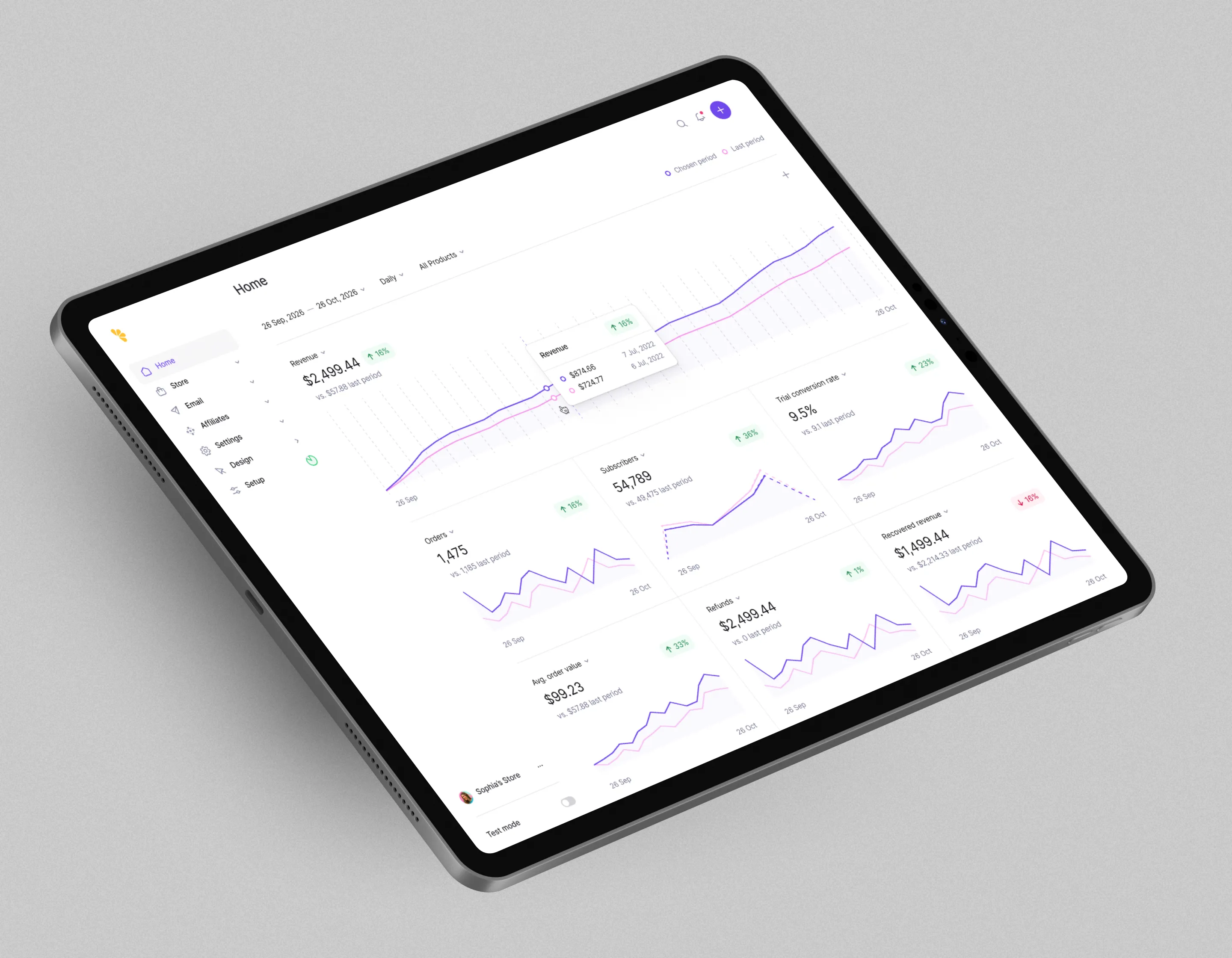
Saas churn beginners guide — Understand how churn impacts your bottom line
Author
Date
Category
We get it, SaaS is sexy but what about the ugly part of SaaS?
Churn.
Today we’re going to deep dive into all things as it relates to SaaS churn.
Often founders, startups, organizations, etc. are quite ‘lax’ with how they calculate their metrics.
Especially churn.
The problem is if you’re off even by a little bit, SaaS churn and revenue compound over time. If you’re not careful it can add up quickly. You’ve got a lot of fires to put out, but do whatever it takes to make time to understand how your company is calculating churn.

Understanding Churn is more important than ever.
Over the years we’ve seen the SaaS model catch on like a wildfire. It’s forcing businesses to hone in on a number of new concerns to consider when branding and marketing their products.
Unlike software purchased a single time, SaaS allows your customers a critical choice at the end of each day, month, or year.
Customers can stay. Or customers can leave.
Really, it’s as simple as that. Yet the rates of users who make one decision are changing the way that companies think about their approach.
You’ve likely heard of “churn”, but how exactly does this affect your business? What does it mean when you hear that nearly one-third of SaaS providers have churn rates that are too high?
We’re here to help you find out, then show you how to take your new knowledge to understand what churn rates mean for your product or service and how to better guide your future directions.
Understanding Types of SaaS churn —Back to Basics
First things first—let’s establish the terminology before we discuss it. Churn comes in a few different flavors, which we’ll outline below.
Customer Churn
Your product’s customer churn rate is a way to measure how often customers choose to unsubscribe from your service. In other words, “churn” is a measure of how frequently a SaaS product is losing customers (and therefore revenue).
Customer churn would, for example, take into account the number of subscribers who cancel their service.
With that said, it doesn’t include customers that downgrade to a less expensive subscription plan. More on that later. Typically this number is calculated using a rolling 30-days (similar to how Stripe calculates it).
With that said, you can take customer churn during any time frame. Daily, monthly or yearly.
In short, this is a really simple way of looking at SaaS churn.
Revenue Churn
Revenue churn measures how much revenue is lost rather than the number of customers lost. While revenue churn appears similar to customer churn, they’re significantly different measurements.
For example, your revenue churn value may differ from customer churn due to the presence of varying subscription packages and income from each subscriber. The revenue from each subscriber is not always the same and revenue churn accounts for this.
It is possible to further break down revenue churn into categories like revenue lost due to downgrades, revenue lost due to cancellations, or revenue lost due to other factors.
These categories can help you perform a more targeted analysis and track customers on different cohorts.
We recommend this as one of the more meaningful ways to track churn. Keep in mind that if you’re only measuring customer churn, your customers are most likely paying different amounts. Using revenue churn, you can make sure you understand how churn is truly impacting your bottom line.
Gross Churn
Gross churn is the total revenue lost each month from canceled subscriptions or customer contracts.
The possibility of expansion revenue (e.g. revenue from upsells, cross-sells, etc.) is not included in its calculation. We’ll circle back to “expansion revenue” in a follow-up post. It’s no secret that asking for more money from existing, happy customers is world’s easier than the work required to acquire new customers.
Gross churn is considered one of the most straightforward ways to consider lost revenue.
Especially for the use of comparison against other services in your brand’s niche.
Net Churn
Net churn takes into account both revenue lost and expansion revenue gained from current customers choosing to upgrade to higher plans. Net churn is a more accurate way to view the full picture of your business during a given time period.
Plus, it’s particularly useful if you’re hoping to examine the growth within your current customer base.
Remember that, while net churn will always be smaller than gross churn, relying solely on net churn measurements can lead to a false sense of security.
Use all of the above types of churn to piece together a more complete sense of your company’s standing.
Net Negative Churn
Unlike other types of churn, it’s a good thing when net negative churn is high.
Negative churn occurs when revenue from your existing customers increases enough to offset revenue lost from customers who unsubscribe from your service. Achieving this should be the goal for any SaaS company.
For example, you may lose a couple of customers for one month, but perhaps 10 of your remaining customers upgraded their subscription package.
In this case, expansion revenue might exceed lost revenue from churned customers, and this is what yields net negative churn.
It’s not one size fits all
Overall, remember that mention of “churn” may be referring to different measurements in different units. Always clarify the type of churn you are discussing and establish the units of time (monthly or annually).
Also, indicate whether you are discussing revenue or customers, and always separate between gross and net values.
We hear a lot of CEOs and founders talking about how great (low) their churn is, but in reality, they don’t truly realize how that churn was being calculated.
At a closer look, it wasn’t what they thought.
Calculating SaaS Churn
Now, grab your calculator. It’s time to crunch some numbers.
Here, we’ll discuss a single in-depth calculation. In this example, let’s calculate monthly customer churn. (Also, don’t miss our post on how to calculate churn.)
To calculate a monthly customer churn rate, you need only two numbers –
- The number of customers you began with, at the start of the month.
- The number of individuals who unsubscribed from your software in the same month.
Divide the number of customers who unsubscribed during the month by the total number of subscribers at the beginning of the month to determine that month’s customer churn.
For example, calculate your January customer churn by imagining that:
- You began the month of January with 100 customers.
- You lost 10 customers during this month.
- You gained 110 new clients in January.
Your churn rate would be 10 divided by 100, or 10%.
Now, let’s figure your customer churn for the month of February.
- You started with 200 customers (90 clients remaining from January + 110 new clients from January).
- You lost 20 customers during the month of February.
- You gained no new clients.
In this case, your February churn rate would be 20 divided by 200—still 10%.
Keep in mind, there’s more to the picture than monthly churn—annual churn rates are just as important, and a monthly churn rate of only 5% can turn into roughly 46% annual churn. Don’t forget the bigger picture when making your calculations.
Hint: Calculate annual customer churn the same way you calculate monthly customer churn—just plug in your yearly figures rather than your monthly data.
What Does This Mean for You?
Next, break down how considerations of churn might change your current business practices.
This will, of course, be different for every SaaS provider, so evaluate your business appropriately when you start compiling data.
However, it’s not enough to just gather a spreadsheet or dashboard full of numerical results. Once you’ve done that, analyze it.
Use the calculations to discover your current strengths and weaknesses – then plan to make changes as necessary.
According to 2017 Private SaaS Company survey results provided by the KBCM Technology Group, the median annual churn rate of the 214 respondents recorded was 11%, up one percent from the previous year’s survey.
However, when compared to the general marker of success for small and medium businesses (less than 10%), that 11% suddenly seems a lot bigger.
With your SaaS churn rates in consideration and context from larger-scale statistics, take a look at your company’s current trends and reevaluate.
Collaborate with your employees and colleagues and prepare for changes. Even if things are going well, understand that no model is perfect and there’s always room for improvement.
Aim for that magical Net Negative Churn.
Calculate, learn & improve your SaaS churn.
Knowledge is power, but improvement will not come without initiative and change.
There’s another critical step one must undertake when considering churn, and that step is to be proactive with your knowledge.
- Understand that churn is a symptom of something larger within your product. Work backward from it to better understand why the people who originally wanted your product now want to leave. For example, implement intelligent exit surveys to understand why a customer is leaving.
- Improve communication with new customers to better understand what attracted them to your product and what they expect from you.
- Develop your marketing campaigns with churn in mind. Ask how can you check-in on a customer’s happiness routinely?
Now that you know the basic principles of SaaS churn, examine your own churn rates, and start implementing changes to improve those numbers.
Good luck.
Whatever stage of your journey, we’re here to help
No matter the stage of your company, we stand behind our promise to provide exceptional customer support, from initial setups to massive migrations and everything in between.
Invest in your business with peace of mind that we're here for you whether you need technical help or business advice.

Creator Guide
Looking for some advice on how to sell and market your digital products? Download the creator’s guide to dive deep into getting your idea off the ground.

Merchant of Record Guide
Free guide for all entrepreneurs and organizations explaining why partnering with a Merchant of Record is more important than you might realize.

Want merch?
Want some fresh Lemon Squeezy swag with all the lemon puns you could ever imagine? The wait is almost over as we’re gearing up for a limited-time merch drop.

Book a demo today and get your own personal guided tour of Lemon Squeezy
Still have questions about Lemon Squeezy? Book a call with our sales team today and we’ll show exactly how we can revolutionize the way your business handles global payments and sales tax forever.

Need help?
If you’re looking to get in touch with support, talk to the founders, or just say hello, we’re all ears.









